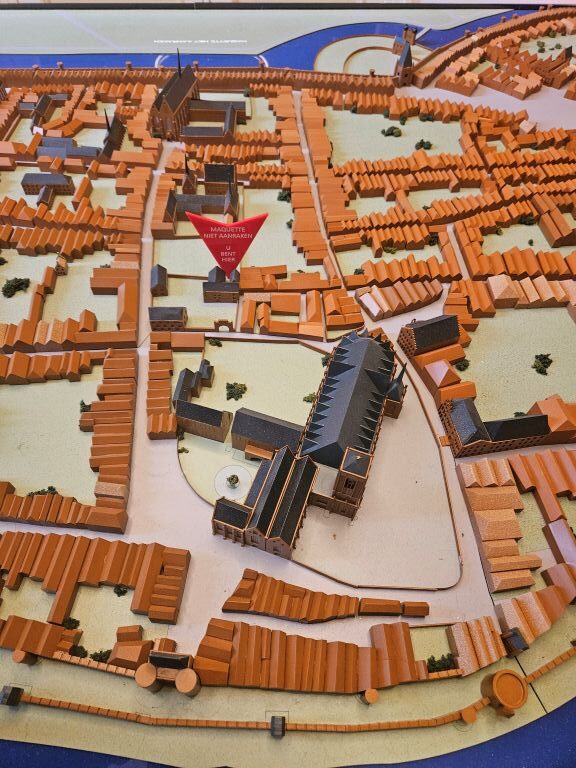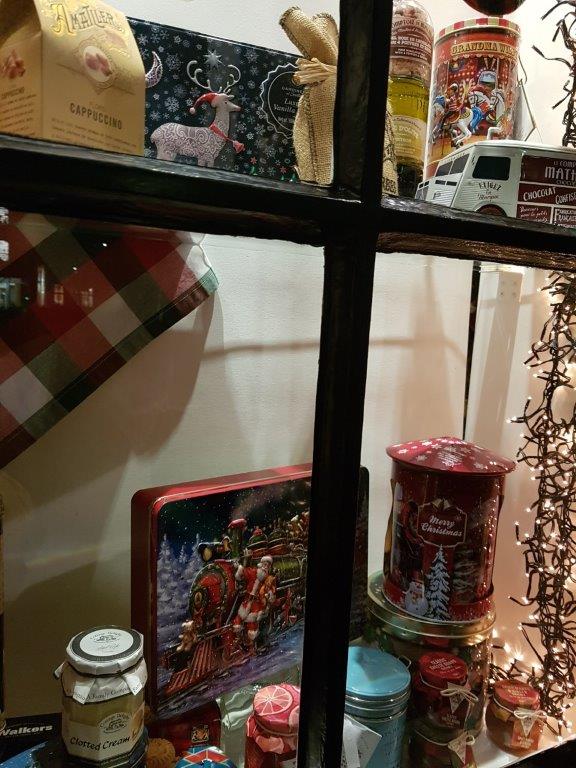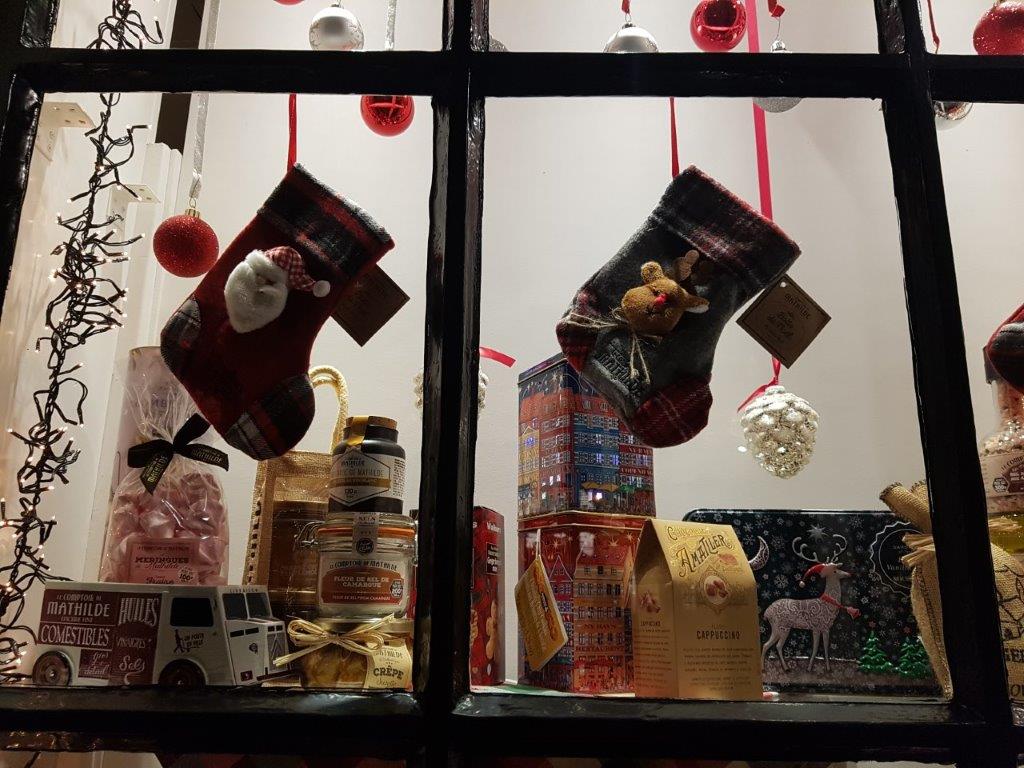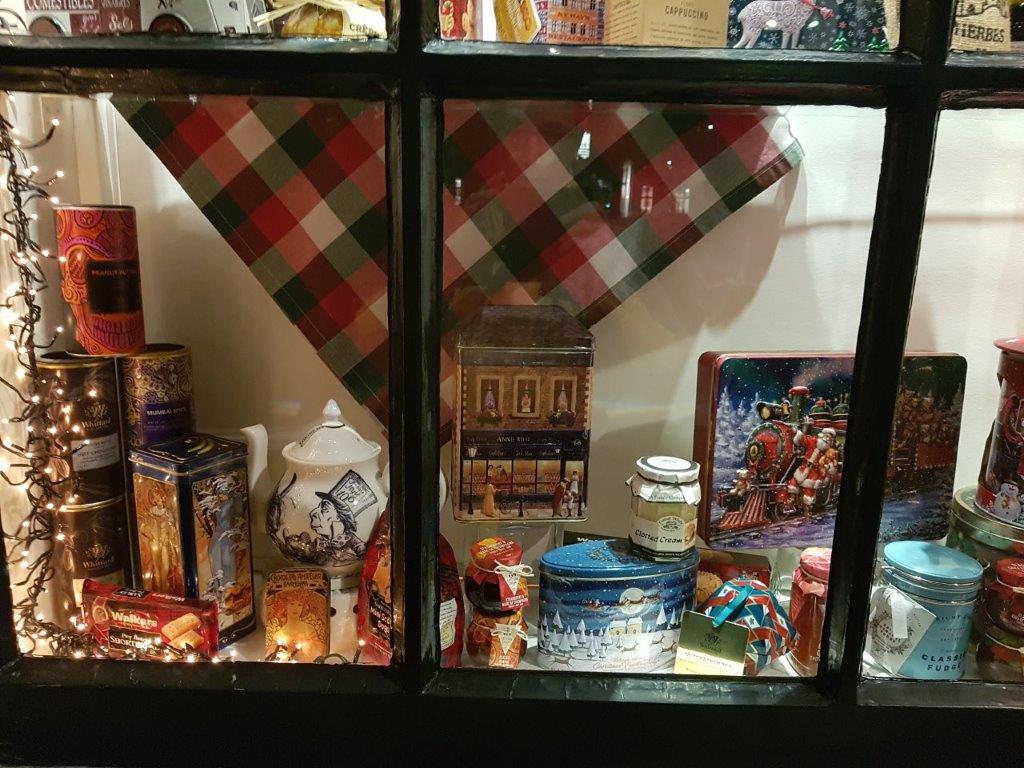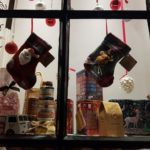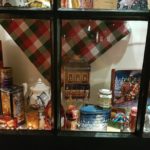Deventer (the ultimate historic walk for history lovers in 4 parts) Part 4
Route and Map Part 4
Part/Map 4:Sandrasteeg–>Lange Bisschopstraat–>Kleine Overstraat/Jordenshof–>Spijkerboorsteeg–>Grote Overstraat–>Pontsteeg–>Lamme van Dieseplein–> Engestraat–> Achter de Broederen–> Smedenstraat–> Korte Bisschopstraat–> Brink–> Keizerstraat–> Stationsplein
Sandrasteeg
Proosdij
In the Sandrasteeg, protected by a glass roof against weather conditions and against bird shit ;-), is the oldest stone build house in the Netherlands named the Proosdij (I didn’t find any translation into English for this word).
 The Proosdij in Deventer is the oldest existing stone house in the Netherlands. Building archaeological research has shown that the oldest core of the building dates from around 1130 and is built from trachyte and tufa, types of stone that were supplied from the Eifel. On the second floor the remnants of three Romanesque windows are present on the front façade. The house is located on the Sandrasteeg and the Stromarkt, in the core of the old city Deventer.
The Proosdij in Deventer is the oldest existing stone house in the Netherlands. Building archaeological research has shown that the oldest core of the building dates from around 1130 and is built from trachyte and tufa, types of stone that were supplied from the Eifel. On the second floor the remnants of three Romanesque windows are present on the front façade. The house is located on the Sandrasteeg and the Stromarkt, in the core of the old city Deventer.
Until the Reformation, the Proosdij was the residence of the provost of the chapter/kapittel of the Lebuïnus Church. The provost was in charge of this college. On the ground floor was a chapel dedicated to Boniface, next to it were reception rooms and living quarters. The building was part of the ecclesiastical area at the Lebuïnus Church.
After the siege of Deventer in 1591, the Calvinist Maurits van Oranje had conquered the city on the Catholic Spaniards. The proosdij was withdrawn from the Catholic Church and came into the hands of the States of Overijssel. The house received several other destinations and was finally sold in 1677 to Major Hendrik de Sandra, a high soldier from the State army, who went to live there with his family. The current Sandrasteeg owes its name to this. An area behind the Proosdij that had been part of the bishop’s court and got a destination in the same period as the market square and has since been called Stromarkt.
The building was squatted in the 1970s and has been ‘alternative’ for decades. In the nineties of the last century it was completely restored and in 1994 the alley on which the façade adjoins was covered to protect the nine hundred years old wallwork against further weather influences.
The nearby Proosdijpassage leads to the former territory of the proosdij where over a long period in time, markets were located. It was only built in the 1980s to improve accesibility of the shopping area.
Walk towards the end of the Sandrasteeg and turn left into the Lange Bisschopstraat (Long Bisshop Street)
Lange Bisschopstraat
The Lange Bisschopstraat borders the south side of the Bisshops Chapter/Kapittel area. It is now one of Deventer’s main shopping streets.
Turn right into the Kleine Overstraat. You’ve now entered the area full of little narrow streets and small pitoresk shops. No major shopping malls overhere 🙂 Follow this street until you see an alley (The Treurnietsgang) to your left. Neglect this alley and look for a small alley going on the right side passed the first house after the Treurnietsgang on the left. This alley will lead you to the Jordenshof, another oasis of peace in this bustling shopping area.
Kleine Overstraat
Connection road (‘overweg’) between Brink and Lange Bisschopstraat.
Jordenshof
The Jordenshof (Kleine Overstraat 25-31) is the only remaining historic courtyard in the Dutch city of Deventer.
Het hofje was originally founded by Joachim Keyzer in the Pontsteeg, but continued by his two sons-in-law Ewold Buser and Hendrik Jordens. The management is still in the hands of the Jordens family. The courtyard was moved in 1856 to the current location at Kleine Overstraat. In 1930 – 1931 the hofje was based on a plan by the Deventer architect ir. W.P.C. Knuttel (1886-1974) renewed. The courtyard has an entrance gate with sandstone elements. In the courtyard there is a memory bank with a masoned brick plaque from 1644, containing all names of the Jordens Family.
Just past the Jordenshof is a small Tea Coffee, Chocolate Bonbon and tea and coffee accessories shop named:
De Bonte Klipper
The shop is cozy, and has in the back an area to quietly enjoy your tea or coffee with cake or chocolate.
Website: https://www.debonteklipper.nl/
Leave the Jordenshof the way you entered. When your at the Kleine Overstraat, turn left and proceed. Then turn left again into the Spijkerboorsteeg.
Spijkerboorsteeg
 Spijkerboorsteeg is named after certain type of hand driven drill: the Spijkerboor. If you look at the Spijkerboorsteeg from above on Google maps, it will show some resemblance to this drill’s shape.
Spijkerboorsteeg is named after certain type of hand driven drill: the Spijkerboor. If you look at the Spijkerboorsteeg from above on Google maps, it will show some resemblance to this drill’s shape.
This area is the top of the first inhabited sand dune.
Proceed and turn left again at the next corner. Walk into the Grote Overstraat.
Grote Overstraat
Another connection road (‘overweg’) between Brink and Lange Bisschopstraat.
![]() Walk toward the end of the Grote Overstraat enjoying all the little stores. Then cross the Lange Bisschopstraat into the Pontsteeg.
Walk toward the end of the Grote Overstraat enjoying all the little stores. Then cross the Lange Bisschopstraat into the Pontsteeg.
Pontsteeg
The Pontsteeg is part of the Bisshop’s Chapter/Kapitel.
![]() Follow the narrow Pontsteeg until to the right the Lamme van Dieseplein appears.
Follow the narrow Pontsteeg until to the right the Lamme van Dieseplein appears.
Lamme van Dieseplein
We’ve now come to the heart of what once was the Kapittel/Chapter where the Bisshop and his entourage lived. This was actually like a mini Vatican city surrounded by walls within the city of Deventer as this maquette shows:
The area around the Lebuinus Church and above the area of the Stromarkt and the Lamme van Dieseplein, are both shown surrounded by walls.
Geert Groote
Gerard Groote (October 1340 – 20 August 1384), otherwise Gerrit or Gerhard Groet, in Latin Gerardus Magnus, was a Dutch Roman Catholic deacon, who was a popular preacher and the founder of the Brethren of the Common Life. He was a key figure in the Devotio Moderna movement.
Religious life
Soon after Groote settled in Cologne, teaching philosophy and theology, and was granted a prebend in Utrecht and another in Aachen. The life of the brilliant young scholar was rapidly becoming luxurious, secular and selfish, when a great spiritual change passed over him which resulted in a final renunciation of every worldly enjoyment. This conversion, which took place in 1374, appears to have been due partly to the effects of a dangerous illness and partly to the influence of a fellow student, Henry de Calcar, the learned and pious prior of the Charterhouse at Munnikhuizen (Monnikenhuizen) near Arnhem, who had remonstrated with him on the vanity of his life.
In 1374 Groote turned his family home in Deventer into a shelter for poor women and lived for several years as a guest of a Carthusian monastery. In 1379, having received ordination as a deacon, he became a missionary preacher throughout the diocese of Utrecht. The success which followed his labors not only in the city of Utrecht, but also in Zwolle, Deventer, Kampen, Amsterdam, Haarlem, Gouda, Leiden, Delft, Zutphen and elsewhere, was immense; according to Thomas à Kempis the people left their business and their meals to hear his sermons, so that the churches could not hold the crowds that flocked together wherever he came.
The bishop of Utrecht supported him warmly, and got him to preach against concubinage in the presence of the clergy assembled in synod. The impartiality of his censures, which he directed not only against the prevailing sins of the laity, but also against heresy, simony, avarice, and impurity among the secular and regular clergy, provoked the hostility of the clergy, and accusations of heterodoxy were brought against him. It was in vain that Groote emitted a Publica Protestatio, in which he declared that Jesus was the great subject of his discourses, that in all of them he believed himself to be in harmony with Catholic doctrine, and that he willingly subjected them to the candid judgment of the Roman Church.
The bishop was induced to issue an edict which prohibited from preaching all who were not in priestly orders, and an appeal to Pope Urban VI was without effect. There is a difficulty as to the date of this prohibition; either it was only a few months before Groote’s death, or else it must have been removed by the bishop, for Groote seems to have preached in public in the last year of his life.
At some period (perhaps 1381, perhaps earlier) he paid a visit of some days’ duration to the famous mystic John Ruysbroeck, prior of the Augustinian canons at Groenendaal near Brussels; during this visit was formed Groote’s attraction for the rule and life of the Augustinian canons which was destined to bear notable fruit. At the close of his life he was asked by some of the clerics who attached themselves to him to form them into a religious order and Groote resolved that they should be Canons Regular of St. Augustine. No time was lost in the effort to carry out the project, but Groote died before a foundation could be made.
The initiation of this movement was the great achievement of Groote’s life; he lived to preside over the birth and first days of his other creation, the society of Brethren of the Common Life. He died of the plague at Deventer, which he had contracted while nursing the sick, in 1384 at the age of 44.
The Brethren of the Common Life
Young men especially flocked to him in great numbers. Some of these he sent to his schools, others he occupied at transcribing good books, to all he taught thorough Christian piety. Groote and Florence Radewyns, his favourite disciple, founded at Zwolle the Brethren of the Common Life. In 1387 a site was secured at Windesheim, some 24 km (15 mi) north of Deventer, and here was established the monastery that became the cradle of the Windesheim Congregation of canons regular embracing in course of time nearly one hundred houses, and leading the way in the series of reforms undertaken during the 15th century by all the religious orders in Germany. Henceforth his communities, which were spreading rapidly through the Netherlands, Lower Germany, and Westphalia, claimed and received all his attention. He contemplated organizing his clerics into a community of canons regular, but it was left to Radewyns, his successor, to realize this plan at Windesheim two years later.
Devotio Moderna
A movement known as the Modern Devotion (Devotio Moderna) was founded in the Netherlands by Groote and Florens Radewyns, in the late fourteenth century. For Grote the pivotal point is the search for inner peace, which results from the denial of one’s own self and is to be achieved by “ardour” and “silence”. This is the heart of the “New Devotion”, the “Devotio moderna”. Solitary meditation on Christ’s Passion and redemption, on one’s own death, the Last Judgment, heaven, and hell was essential.
In the course of the 15th century, the Modern Devotion found adherents throughout the Netherlands and Germany. Its precepts were further disseminated in texts such as The Imitation of Christ by Thomas à Kempis, which reached an increasingly literate public. In this context small works of art such as diptychs that provided a focus for private worship enjoyed wide popularity.
Lamberta van Diese
 The square which has more the character of a quiet, peaceful courtyard, was named after Lamberta (Lamme) van Diese. She founded a house for Sisters of Common Life (Zusters van het Gemene Leven), the Lamme of Diesehuis which was located at the Pontsteeg. The basis for founding the Community (of women) of the Sisters of Common Life was laid out by Geert Groote (1340-1384). These sisters shared possessions, lived frugal and devoted their time, besides to work (including of spinning and weaving of fabrics, care for the sick and poor people and copying of texts) to (self-)reflection and prayer.
The square which has more the character of a quiet, peaceful courtyard, was named after Lamberta (Lamme) van Diese. She founded a house for Sisters of Common Life (Zusters van het Gemene Leven), the Lamme of Diesehuis which was located at the Pontsteeg. The basis for founding the Community (of women) of the Sisters of Common Life was laid out by Geert Groote (1340-1384). These sisters shared possessions, lived frugal and devoted their time, besides to work (including of spinning and weaving of fabrics, care for the sick and poor people and copying of texts) to (self-)reflection and prayer.
 These Sister of the Common Life lived in four buildings of which we can still find some remains in and around Deventer. The Lamme van Diese Huis (dedicated to the holy Cecilia) has not survived except for the small Cecilla Chapel, of which the ruined remains can be found near the Pontsteeg.
These Sister of the Common Life lived in four buildings of which we can still find some remains in and around Deventer. The Lamme van Diese Huis (dedicated to the holy Cecilia) has not survived except for the small Cecilla Chapel, of which the ruined remains can be found near the Pontsteeg.
You visited the Buiskenshuis on the Klooster in a previous part of this historic walk. It is now housing the City Archives and Athenaeum Library.
The Brandes- en Kerstekenshuis is located in the Bagijnenstraat (you will not visit this on this walk).
Orignally they lived in the Meester Geertshuis, which can still be found in de Assenstraat (20), which you will not visit during this walk.
I never noticed this before, but since 2025 there seems to be a tiny “Lamme van Diese” that climbed up the chapel’s wall:
Geert Groote Huis
 The glass building on the square, is the quite new Geert Groote Huis, devoted to teaching about Geert Groote and devoted to letting people experience what his teachings were about. It was build upon an anciet medieaval cellar, which is also accessible.
The glass building on the square, is the quite new Geert Groote Huis, devoted to teaching about Geert Groote and devoted to letting people experience what his teachings were about. It was build upon an anciet medieaval cellar, which is also accessible.
If you’d like to see how the achitecture of the Kapittel, the chapter where the Bisshops and their entourage lived, looked like when it was still intact, than do visit the Geert Groote Huis, because they have great scale models to observe.
 If your standing on the middle of the Lamme van Dieseplein, then it is a bit like an empty, but quite pieceful courtyard. But you should know that all of this emptiness was once a large complex of buildings.
If your standing on the middle of the Lamme van Dieseplein, then it is a bit like an empty, but quite pieceful courtyard. But you should know that all of this emptiness was once a large complex of buildings.
Website: http://www.geertgrootehuis.nl/
The Kapittel was like
Books and the written word
Previously during this walk, I explained about the largest book market in Europe, about the importance of education through books via the Latin School and Atheneum Library and the City Archives and we passed the beautiful new location of the Public Library. I showed the location where Publisher Kluwer once started its 1st offices. In short: Deventer breaths books.
The importance of the protection keeping and spreading (by copying) of the written word for the Sisters of Common Life was the spark that ignited this book culture in Deventer. This was its cradle.
![]() After looking around and maybe a visit to the Geert Grootehuis, return to the Pontsteeg and maybe visit one of the shops there, like e.g: De 3 ridders (The three knights) and proceed to follow it in the opposite direction from whence you arrived, walking past the Cecila Chapel to the end of the Pontsteeg. Then turn right. You’ve now reached the Engestraat.
After looking around and maybe a visit to the Geert Grootehuis, return to the Pontsteeg and maybe visit one of the shops there, like e.g: De 3 ridders (The three knights) and proceed to follow it in the opposite direction from whence you arrived, walking past the Cecila Chapel to the end of the Pontsteeg. Then turn right. You’ve now reached the Engestraat.
De 3 ridders
De 3 ridders was a small specialty shop selling all sorts of English and French delicacies, often beautifully wrapped or packaged. It stopped in 2023.
Engestraat
Narrow street that ran from the Nieuwe Markt towards the Broederen kerk and onwars towards the Deventer enk, which was an agriculture field near the Boxbergerweg. In those days the city stopped behind the Broederenkerk. The part of the road running from the church towards the field is gone. I’m not sure whether the name Engestraat is derived from the fact that it was a narrow (in Dutch: enge) street or that the word Enk became Enge.
![]() Proceed towards the Broederenkerk in front of you which has its entrance in the Broederenstraat coming from the right.
Proceed towards the Broederenkerk in front of you which has its entrance in the Broederenstraat coming from the right.
Broederenkerk
The Broederenkerk is located where the Engestraat meets the Broederenstraat (right).
 The Broederenkerk, officially the Roman Catholic Saint-Lebuïnus Church, is a church in Deventer, built between 1335 and 1338 by order of Eleonora of England, then Duchess of Guelders. Before the church was built, around 1300 there was already a monastery founded by the Franciscan Friars. Although the brothers definitively left monastery and church in 1579, the informal but perfectly established name of the Godshuis reminds of their centuries-long presence. From 1579 to 1799, the church building, with a short interruption, was used by Deventer Protestants.
The Broederenkerk, officially the Roman Catholic Saint-Lebuïnus Church, is a church in Deventer, built between 1335 and 1338 by order of Eleonora of England, then Duchess of Guelders. Before the church was built, around 1300 there was already a monastery founded by the Franciscan Friars. Although the brothers definitively left monastery and church in 1579, the informal but perfectly established name of the Godshuis reminds of their centuries-long presence. From 1579 to 1799, the church building, with a short interruption, was used by Deventer Protestants.
History
The Christian faith confessed in the church has changed the denomination several times. Before the church was assigned to the Calvinists in 1579, the church was for a long time a convent church open to the city dwellers. The late medieval penitentiary Geert Grote, one of the most important founders of the Modern Devotion, regularly attended Mass and perhaps also preached there. The church came into the hands of the Calvinists as a result of the Dutch Revolt in 1579, but from 1587 it was available for the Catholics of Deventer for several years.
When Deventer was conquered by Prince Maurits in 1591, the Protestants finally took control of the church. Among others, the Walloon municipality has used the building for its services for a long time. The church was used around 1795 as a military warehouse for English troops and then as a French barracks. During the Batavian Republic, the church buildings of Deventer were again divided between the different religious divisions. The Broederenkerk thus came into possession of the Deventer Catholic community in 1799, for the first time after two centuries. She was put back into service on May 26, 1803, Ascension Day. The church was almost completely rebuilt at the end of the nineteenth century and expanded in early neo-Gothic style. Only the roof construction can still be called medieval.
Restoration
In 2012 and 2013, the church was not in use due to large-scale repair work on in- and extrusions. Fifteen linden wood saints statues made around 1860 in the Cuypers-Stoltzenberg workshop in Roermond were restored on this occasion by the Deventer sculptor Karoly Szekeres. In December 2013, the cross was placed back on the façade, which made the church officially suitable for celebrations.
After a visit to the Broederenkerk, enjoying its beautifully rstorated interior (in slince plese, because it is a Center of Silence, reminding you of the teachings of Geert Groote), leave the church through its main entrance and turn right and immediately right again (twice). Your now passing the small monumental houses that are build against the church on your right.
Broederenstraat/Achter de Broederen/Broederenplein
You’ve left the church at the Broederenstraat which was the street where the Fransiscan Minderbroeders (Friars) founded their church.
The next street following the above directions is Achter de Broederen (Behind the Brethren).
Ursula Chapel
Left is the Broederenplein. Walk onto the square next to the buildings on your left. If you look closely onto the pavement of the Broederenplein you’ll notice in light colored stone, the contours of an older chapel. The St. Ursula chapel and the statue of 0662. The chapel was a small one-aisled church with semicircular choir closure. In the pavement it is indicated that in 1969 foundations of the St. Ursula chapel have been uncovered.
Return to Achter de Broederen and face the church. Turn left and follow Achter de Broederen to its end. Turn right into the Smedenstraat.
Smedenstraat
You’re now in the shopping area of the Smedenstraat. I’ve explained the meaning of this street before. It was at the edge of the Medieaval town and behind it the first city wall was build and behind that the inner moat. The Walstraat which boards the inner moat is an extension of the streets where we walk now. Just before the end of the street you’ll find a narrow alley to the left named Smidsgang. Again a reference to the Blacksmiths that were banished to this area to prevent fires from destroying the town center.
Follow the Smedenstraat until it changes into the Korte Bisschopstraat (Short Bisshop Street).
Korte Bisschopstraat
The Korte and the Lange Bisshopstraat are leading to the bishop’s court at the Lebuïnus Church. Also known as the Short B. (and Long B.).
At the end of the Korte Bisschopstraat you’ll reach the Brink again and are in the opportunity to spend some time on one of its many terraces.
Brink
You might wanna visit the Deventer Cookie shop or the Waag Museum, or spend some time in Bookshop Praamstra at the corner of the Brink, Keizerstraat and Walstraat. This bookshop boasts an excellent collection of books ranging from encyclopedia’s to atlasses and old photobooks about Deventer and its impressive history.
https://www.boekhandelpraamstra.nl
From the end of the Korte Bisschopstraat, turn left and leave the Brink through the Keizerstraat. Keep following this road to its end at the outer moat.
Keizerstraat
Proceeding through the Keizerstraat which was an important main entrance road to the city center and the Brink, in thought, you’ll pass through all the city gates and walls mentioned before and we pass the Brinkpoortstraat again, on your left, before reaching the outer moat and the last gate.
Cross the Singel and use the pedestrian/cyclist bridge to cross the former area of the outer moat, which is now an underground cycle garage and reach the Stationsplein.
Stationsplein
Leeuwenbrug
The pedestrian bridge is located at a spot where in 1881 the old Leeuwenbrug (Lion Bridge) was located, crossing the outer moat, flanked by 4 lion statues.
![]()
Proceed towards the Railway station where this historic walk ends. Have a nice and safe journey home and hopefully see you soon on one of the many terraces, parks or shopping streets or festivals of Deventer.
Conclusion
The succesfull development of Deventer was actually caused by a chain reaction of coincedence and clever reactions on mostly negative circumstances.
Failure is the greatest teacher of all!
The chain reaction:
1st farmers –> River floodings –> Settlements on top of Dunes –> Attacks by Vikings –> Defensive wall –> Relative Safety –> Bisshop chooses Deventer as seat –> Growth in population and wealth need of –> More luxureous high quality buildings–> need for written texts to educate students –> Copying of books/written texts –> Latin School –> Athenaeum Library –> large city fires –> wood and reed replaced by stone and roof tiles –> need of raw materials and food –> trade grows –> markets –> Membership of Hanze –> Even more wealth –> Population grows –> Invasions –> City Walls are extended and modernized –> Important role in the defense of the young Dutch Republic.
Sources
Although this article is not pretending to be a scientifically based article, full of quotes, but is meant to provide an overview of the origin and further development of Deventer, supporting a long city walk, I will nonetheless mention some of my sources, of which I have no doubt at all that they will be available at the Praamstra bookshop (corner Brink/Keizerstraat):
- Geschiedenis van Deventer Deel 1: Oorsprong en middeleeuwen, Henk Slechte; Walburg Pers
- Historische atlas van Deventer: Hanzestad aan IJssel en Schipbeek, Clemens Hogenstijn;VanTilt
- Deventer gaandeweg: Beelden van straten in Deventer uit de collectie van fotograaf Albert Heijink, Albert Heijink en René Aarnink
- De Geest van Lebuïnus: Het eerste (verantwoorde) beeldverhaal over de historie van Daventria Deel 1 De Lebuïnuskelk en Deel 2 Noormannen & Bisschoppen, Hans Stempher; Artnik









